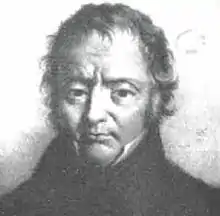
Carlo Lauberg, later known as Charles Jean Laubert (Teano, September 8, 1762 – Paris, November 3, 1834), was an Italian politician, revolutionary, and scientist.
Biography
The son of an officer of Walloon origin belonging to the Spanish army that accompanied Charles of Bourbon in the conquest of the Kingdom of Naples in 1734,[1] after serving as a professor of mathematics and sciences at the royal schools of Chieti and Nunziatella, and in his youth being a cleric of the Piarist order, in 1792 Carlo Lauberg, along with Annibale Giordano, opened the so-called Academy of Chemistry in Naples, which became a circle in support of the French Revolution. Many young pro-republican students, such as Antonio Savaresi, attended its sessions. At the end of 1792, he was one of the Neapolitans who met the French admiral Latouche-Tréville and, as a result of these encounters, were persecuted by Ferdinand IV of Naples. A Freemason, in 1793, starting from Masonic lodges, Lauberg founded, along with other Brothers, including Francesco Saverio Salfi and Francesco Mario Pagano, the "Patriotic Society" or "Jacobin Society of Naples".[2] In 1794, he was forced to flee Naples and took refuge in Oneglia, which had been conquered a year earlier by the French troops of General Anselme and was then administered by the revolutionary commissioner Filippo Buonarroti. Later, he enlisted as a pharmacist in the military health corps.
In 1796, accompanying the Napoleonic army, Carlo Lauberg descended to Italy and returned to Naples with General Championnet on December 5, 1798. On January 23, 1799 (4th day of Pluviôse in the new calendar), by decree of Championnet, he was appointed president of the provisional and constituent government of the Neapolitan Republic. Like many rulers who had been exiles in France, Lauberg was considered uncompromising, and his policies were opposed by both the "good republicans" (moderates) led by Ignazio Ciaia and the former aristocrats. Carlo Lauberg's authority also suffered due to the difficulties faced by Championnet, who had been recalled to France, arrested on February 24, 1799, and replaced by General Étienne MacDonald. Therefore, on February 25, 1799, Carlo Lauberg was replaced at the helm of the Neapolitan Republic by Ignazio Ciaia.
Having abandoned political activities, he returned to France where he pursued a career as a pharmacist. After obtaining French citizenship, he changed his name to Charles Jean Laubert and lived in Paris, where he also engaged in research activities.[3] He was responsible for isolating and studying the properties of quinine.[4]
Works
- Annibale Giordano and Carlo Lauberg, Principj analitici delle matematiche, vol. 2, Naples, Gennaro Giaccio, 1792.[5]
- Relazione sulla condotta tenuta dai Romani verso i Francesi dall'epoca della pace di Tolentino fino al giorno d'ogg, Venice, Giovanni Zatta, 1797.
Honors
- Knight of the Order of the Legion of Honor
Recognitions
- Member of the Académie nationale de médecine.
- The genus Laubertia of the Apocynaceae family is named after him.[6]
Bibliography
- Benedetto Croce, "La vita di un rivoluzionario: Carlo Lauberg", in Benedetto Croce, Vite di avventure di fede e di passioni, Bari: Laterza, 1936. Originally published in La Critica, 1934. Also available in the edition edited by Giuseppe Galasso, Milano: Adelphi edizioni, 1989, pp. 363–437, ISBN 8-845-90682-5
- Nunzio Campagna, "Un ideologo italiano, Francesco Lomonaco", Milano: Marzorati, 1986, p. 31, ISBN 88-280-0048-1.[7]
- Anna Maria Rao, "La Repubblica napoletana del 1799", Roma: Newton, Tascabili economici Newton, 1999, ISBN 88-8183-608-4.
- Nico Perrone, "La Loggia della Philantropia," Palermo: Sellerio, 2006, ISBN 88-389-2141-5.
- Renata De Lorenzo, "LAUBERG, Carlo Giovanni", in Dizionario biografico degli italiani, vol. 64, Roma, Istituto dell'Enciclopedia Italiana, 2005.
References
- ↑ Journal de pharmacie et des sciences accessoires (in French). Chez L. Colas Fils. 1834.
- ↑ "La fase "giacobina" delle Logge italiane" (PDF). massoneriascozzese.it. Retrieved 2024-01-12.
- ↑ Folie, Charles Jean La (1823). Histoire de l'administration du royaume d'Italie pendant la domination française ... (in French). Audin.
- ↑ Jean Laubert, Charles (1816). "Recherches botaniques, chimiques, pharmaceutiques sur la Quinquina". Journal de médecine, de chirurgie ed de Pharmacie militaires.
- ↑ Giordano, Annibale (1792). Principj analitici delle matematiche di Annibale Giordano, e Carlo Laubberg: Geometria (in Italian). presso Gennaro Giaccio.
- ↑ Quattrocchi, Umberto (1999-11-23). CRC World Dictionary of Plant Names: Common Names, Scientific Names, Eponyms, Synonyms, and Etymology. Taylor & Francis US. ISBN 978-0-8493-2676-9.
- ↑ Campagna, Nunzio (1986). Un ideologo italiano, Francesco Lomonaco (in Italian). Marzorati. ISBN 978-88-280-0048-8.
External links
- Lauberg, Carlo, treccani.it. – Enciclopedia on line, Enciclopedia Italiana di Scienze
- Attilio Simioni, "LAUBERG, Carlo", in Enciclopedia Italiana, vol. 20, Istituto dell'Enciclopedia Italiana, 1933.
- Works by Carlo Lauberg on openMLOL, Horizons Unlimited srl.
- Works by Carlo Lauberg on Open Library, Internet Archive
- Information about Carlo Lauberg and the Neapolitan Republic of 1799 on the website of the Associazione Erchemperto di Teano.